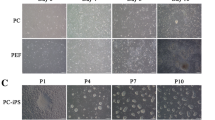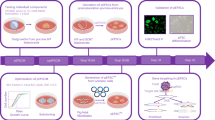Abstract
Reprogramming of pig somatic cells to induced pluripotent stem cells provides a tremendous advance in the field of regenerative medicine since the pig represents an ideal large animal model for the preclinical testing of emerging cell therapies. However, the current generation of pig-induced pluripotent stem cells (piPSCs) require the use of time-consuming and laborious retroviral or lentiviral transduction approaches, in order to ectopically express the pluripotency-associated transcription factors Oct4, Sox2, Klf4 and c-Myc, in the presence of feeder cells. Here, we describe a simple method to produce piPSC with a single transfection of a CAG-driven polycistronic plasmid expressing Oct4, Sox2, Klf4, c-Myc and a green fluorescent protein (GFP) reporter gene, in gelatine-coated plates, with or without feeder cells. In our system, the derivation of piPSCs from adult pig ear fibroblasts on a gelatine coating showed a higher efficiency and rate of reprogramming when compared with three consecutive retroviral transductions of a similar polycistronic construct. Our piPSCs expressed the classical embryonic stem cell markers, exhibit a stable karyotype and formed teratomas. Moreover, we also developed a simple method to generate in vitro spontaneous beating cardiomiocyte-like cells from piPSCs. Overall, our preliminary results set the bases for the massive production of xeno-free and integration-free piPSCs and provide a powerful tool for the preclinical application of iPSC technology in a large animal setting.






Similar content being viewed by others
References
Takahashi, K., & Yamanaka, S. (2006). Induction of pluripotent stem cells from mouse embryonic and adult fibroblast cultures by defined factors. Cell, 26(4), 663–676.
Maherali, N., Sridharan, R., Xie, W., Utikal, J., Eminli, S., Arnold, K., et al. (2007). Directly reprogrammed fibroblasts show global epigenetic remodeling and widespread tissue contribution. Cell Stem Cell, 1, 55–70.
Okita, K., Ichisaka, T., & Yamanaka, S. (2007). Generation of germline-competent induced pluripotent stem cells. Nature, 448, 313–317.
Wernig, M., Meissner, A., Foreman, R., Brambrink, T., Ku, M., Hochedlinger, K., et al. (2007). In vitro reprogramming of fibroblasts into a pluripotent ES-cell-like state. Nature, 448, 318–324.
Yu, J., Vodyanik, M. A., Smuga-Otto, K., Antosiewicz-Bourget, J., Frane, J. L., Tian, S., et al. (2007). Induced pluripotent stem cell lines derived from human somatic cells. Science, 318, 1917–1920.
Aasen, T., Raya, A., Barrero, M. J., Garreta, E., Consiglio, A., Gonzalez, F., et al. (2008). Efficient and rapid generation of induced pluripotent stem cells from human keratinocytes. Nature Biotechnology, 26(11), 1276–1284.
Kim, J. B., et al. (2008). Pluripotent stem cells induced from adult neural stem cells by reprogramming with two factors. Nature, 454, 646–650.
Giorgetti, A., Montserrat, N., Aasen, T., Gonzalez, F., Rodríguez-Pizà, I., Vassena, R., et al. (2009). Generation of induced pluripotent stem cells from human cord blood using OCT4 and SOX2. Cell Stem Cell, 5(4), 353–357.
Sun, N., Panetta, N. J., Gupta, D. M., Wilson, K. D., Lee, A., Jia, F., et al. (2009). Feeder-free derivation of induced pluripotent stem cells from adult human adipose stem cells. Proceedings of the National Academy of Sciences of the United States of America, 106(37), 15720–5.
Nakagawa, M., Koyanagi, M., Tanabe, K., Takahashi, K., Ichisaka, T., Aoi, T., et al. (2008). Generation of induced pluripotent stem cells without Myc from mouse and human fibroblasts. Nature Biotechnology, 26(1), 101–6.
Zhou, W., & Freed, C. R. (2009). Adenoviral gene delivery can reprogram human fibroblasts to induced pluripotent stem cells. Stem Cells, 27(11), 2667–74.
Stadtfeld, M., Nagaya, M., Utikal, J., Weir, G., & Hochedlinger, K. (2008). Induced pluripotent stem cells generated without viral integration. Science, 322(5903), 945–9.
Okita, K., Nakagawa, M., Hyenjong, H., Ichisaka, T., & Yamanaka, S. (2008). Generation of mouse induced pluripotent stem cells without viral vectors. Science, 322, 949–953.
Gonzalez, F., Barragan Monasterio, M., Tiscornia, G., Montserrat Pulido, N., Vassena, R., Batlle Morera, L., et al. (2009). Generation of mouse-induced pluripotent stem cells by transient expression of a single nonviral polycistronic vector. Proceedings of the National Academy of Sciences of the United States of America, 106(22), 8918–8922.
Woltjen, K., Michael, I. P., Mohseni, P., Desai, R., Mileikovsky, M., Hämäläinen, R., et al. (2009). piggyBac transposition reprograms fibroblasts to induced pluripotent stem cells. Nature, 458(7239), 766–770.
Yu, J., Hu, K., Smuga-Otto, K., Tian, S., Stewart, R., Slukvin, I. I., et al. (2009). Human induced pluripotent stem cells free of vector and transgene sequences. Science, 324(5928), 797–801.
Kaji, K., Norrby, K., Paca, A., Mileikovsky, M., Mohseni, P., & Woltjen, K. (2009). Virus-free induction of pluripotency and subsequent excision of reprogramming factors. Nature, 458(7239), 771–775.
Huangfu, D., Maehr, R., Guo, W., Eijkelenboom, A., Snitow, M., Chen, A. E., et al. (2008). Induction of pluripotent stem cells by defined factors is greatly improved by smallmolecule compounds. Nature Biotechnology, 26, 795–797.
Park, I. H., Zhao, R., West, J. A., Yabuuchi, A., Huo, H., Ince, T. A., et al. (2008). Reprogramming of human somatic cells to pluripotency with defined factors. Nature, 451, 141–146.
Li, W., & Ding, S. (2010). Generation of novel rat and human pluripotent stem cells by reprogramming and chemical approaches. Methods in Molecular Biology, 636, 293–300.
Liao, J., Cui, C., Chen, S., Ren, J., Chen, J., Gao, Y., et al. (2009). Generation of induced pluripotent stem cell lines from adult rat cells. Cell Stem Cell, 4(1), 11–5.
Liu, H., Zhu, F., Yong, J., Zhang, P., Hou, P., Li, H., et al. (2008). Generation of induced pluripotent stem cells from adult rhesus monkey fibroblasts. Cell Stem Cell, 3, 587–590.
Kim, H.-I., Yu, J. E., Lee, S. Y., Sul, A. Y., Jang, M. S., Rashid, M. A., et al. (2009). The effect of composite pig islet-human endothelial cell grafts on the instant blood-mediated inflammatory reaction. Cell Transplantation, 18(1), 31–37.
Esteban, M. A., Xu, J., Yang, J., Peng, M., Qin, D., Li, W., et al. (2009). Generation of induced pluripotent stem cell lines from Tibetan miniature pig. The Journal of Biological Chemistry, 284(26), 17634–17640.
Ezashi, T., Telugu, B. P., Alexenko, A. P., Sachdev, S., Sinha, S., & Roberts, R. M. (2009). Derivation of induced pluripotent stem cells from pig somatic cells. Proceedings of the National Academy of Sciences of the United States of America, 106(27), 10993–10998.
Wu, Z., Chen, J., Ren, J., Bao, L., Liao, J., Cui, C., et al. (2009). Generation of pig induced pluripotent stem cells with a drug-inducible system. The Journal of Biological Chemistry, 1(1), 46–54.
Ory, D. S., Neugeboren, B. A., & Mulligan, R. C. (1996). A stable human-derived packaging cell line for production of high titer retrovirus/vesicular stomatitis virus G psuedotypes. Proceedings of the National Academy of Sciences of the United States of America, 93(21), 11400–11406.
Choi, S. C., Yoon, J., Shim, W. J., Ro, Y. M., & Lim, D. S. (2004). 5-azacytidine induces cardiac differentiation of P19 embryonic stem cells. Experimental & Molecular Medicine, 36(6), 515–23.
Brevini, T. A., Antonini, S., Cillo, F., Crestan, M., & Gandolfi, F. (2007). Porcine embryonic stem cells: facts, challenges and hopes. Theriogenology, 68(Suppl 1), S206–213.
Brevini, T. A., Antonini, S., Pennarossa, G., & Gandolfi, F. (2008). Recent progress in embryonic stem cell research and its application in domestic species. Reproduction in Domestic Animals, 43(Suppl. 2), 193–199.
Acknowledgements
We are grateful to Meritxell Carrió and Laetitia Casano for expert assistance with cell culture techniques, José Miguel Andrés Vaquero for assistance with flow cytometry, Lola Mulero Pérez, Cristina Pardo and Mercé Gaudes Martí for bioimaging assistance, Cristina Gómez and Cristina Morera for expert assistance in molecular biology techniques. NM was partially supported by Juan de la Cierva Program, EG was partially supported by Sara Borrell Program, AMCR supported by Fundação para a Ciência e Tecnologia. This work was partially supported by grants from MICINN, TERCEL, CIBER and Fundación Cellex.
Author information
Authors and Affiliations
Corresponding author
Additional information
Núria Montserrat and Elena Garreta Bahima contributed equally to this work
Electronic supplementary material
Below is the link to the electronic supplementary material.
(9.62 MB)
Rights and permissions
About this article
Cite this article
Montserrat, N., Bahima, E.G., Batlle, L. et al. Generation of Pig iPS Cells: A Model for Cell Therapy. J. of Cardiovasc. Trans. Res. 4, 121–130 (2011). https://doi.org/10.1007/s12265-010-9233-3
Received:
Accepted:
Published:
Issue Date:
DOI: https://doi.org/10.1007/s12265-010-9233-3




